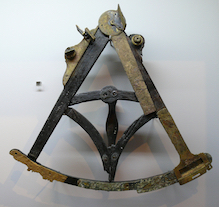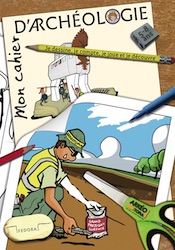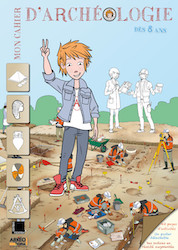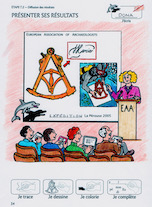Archaeologists Like to Talk
- Last Updated: Tuesday, 28 June 2022 10:13
- Published: Monday, 07 February 2022 15:53
- Written by Jean-Olivier Gransard-Desmond translated by Chloé Walot
- Hits: 5024
Join Augustin, Alex, Lisa and the whole team of ArkeoTopia, to discover additional resources for step 7.2 in My Archaeology Book about dissemination of results of an archaeological study and it’s communication to peers.
Step 7.2 - Dissemination of results
Present your results
Corresponding pages in MAB1 and MAB2
MBA 1, p. 34 and MBA 2, pp. 40-41
More about the step’s reference artifact
 |
|
| Le sextant Mercier au Musée maritime de Nouvelle-Calédonie Inv. FAI 05-264 © Photo Marie Arnautou, MMNC / coll. Drassm-MCC / Dépôt Musée maritime de Nouvelle-Calédonie. |
The drawing in My Archaeology Book titled Present your results was inspired by the sextant signed Mercier. Archaeologists use this way to disseminate their answers and the remaining obstacles of an archaeological study.
Archaeologists, like all other scientists, communicate about their results orally during symposiums. A scientist's symposium is a social gathering of fellow colleagues of the same domain. Fellow colleagues means specialized scientists working on very diverse topics such as Lisa who is working on 18th century shipwrecks. Some symposiums are very specialized, others are more general. They take place once a year or sometimes once every five years. A symposium brings together archaeologists of all nationalities. This is why it is required to speak English to understand and to be understood. Such is the case of the Annual Meeting of the European Association of Archaeologists, at which Lisa is taking part in this illustration.
Lisa embodies one of the archaeologists of the Association Salomon. Like this archaeologist did it, from her lectern, Lisa sets forth the discovery of an unusual sextant. What is a sextant? It is a navigation instrument. The sextant, as well as the octant, makes it possible to get the latitude by measuring solar and stellar heights. However, around 1730, the sextant replaced the octant because its angular coverage is wider. Indeed, the coverage increased from 45° for the octant to 60° for the sextant. Taking measurements became easier by using the sextant.
Why is this sextant special? Manufactured by the optician called Mercier, this sextant was found on La Pérouse expedition’s shipwreck site at Vanikoro on the Solomon Islands in 2005, thanks to the work of the Association Salomon. Among the embarked objects listed for the French ships, this specific sextant appears on the Boussole’s list and not on her sister ship Astrolabe's one. This is the way that the archaeologists of the Association Salomon were able to identify with absolute certainty the wreck of the Boussole which was commanded by Monsieur de La Pérouse. This discovery has helped to better understand the site they had been studying for years.
Nowadays, the Mercier sextant is shown at the Maritime Museum of New Caledonia in Noumea under the inventory number FAI 05-264.
Clues
The 8 clues include:
- The presence of a projection screen
- The slide that displays Lisa’s results
- The hosting organization of Lisa’s presentation (gathering professionals and non-professionals, the European Association of Archaeologists is the most important organization of archaeology having a seat at the Council of Europe)
- Seats
- The seated audience taking notes of Lisa’s lecture
- Lisa’s clothes corresponding to urban dress code (different from those used for fieldwork and lab work)
- The lectern from which Lisa is speaking
- The microphone used by Lisa to be heard
Writing up ResultsMy Archaeology Book
Resources HomepageStep 8.1 - Using Archaeo
Guided Tours
 |
 |
|
My Archaeology Book 1 |
My Archaeology Book 2 |

 My Archaeology Book, or MAB, is an activity workbook that combines creativity, fun and learning. Alongside young Augustin, a curious and courageous boy, children meet Alex and Lisa, two friendly archaeologists who will lead them to discover archaeology and French heritage. Each drawing illustrates a situation that Alex and Lisa might encounter at work. Depending on the age of the child and the workbook, children follow easy-to-understand symbols in order to experiment with activities such as coloring, drawing, observation games, riddles and reading in order to see the world through an archaeologist’s eyes. Alone, with family, at school or just for fun, children expand their knowledge and gain skills, all while having fun.
My Archaeology Book, or MAB, is an activity workbook that combines creativity, fun and learning. Alongside young Augustin, a curious and courageous boy, children meet Alex and Lisa, two friendly archaeologists who will lead them to discover archaeology and French heritage. Each drawing illustrates a situation that Alex and Lisa might encounter at work. Depending on the age of the child and the workbook, children follow easy-to-understand symbols in order to experiment with activities such as coloring, drawing, observation games, riddles and reading in order to see the world through an archaeologist’s eyes. Alone, with family, at school or just for fun, children expand their knowledge and gain skills, all while having fun.
On this section, you will find additional resources: color photos of archaeological documents that inspired My Archaeology Book, additional teaching documents (flip-book, websites, suggestions for classroom use, edutainement, etc.) and information on upcoming publications. Each page will be updated over time.







